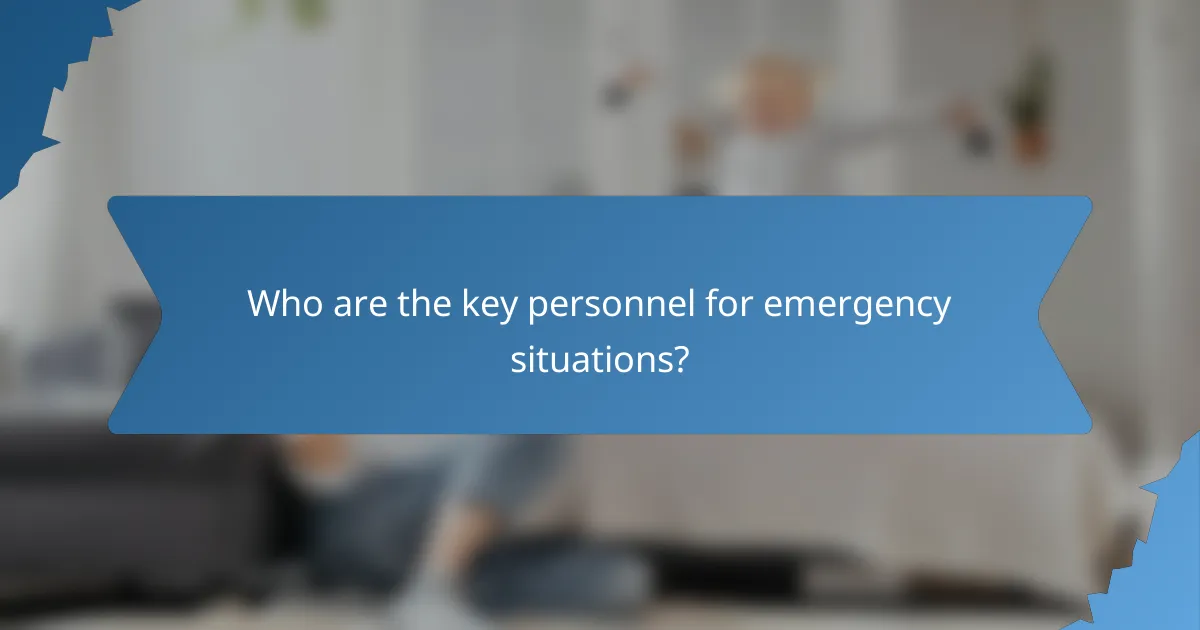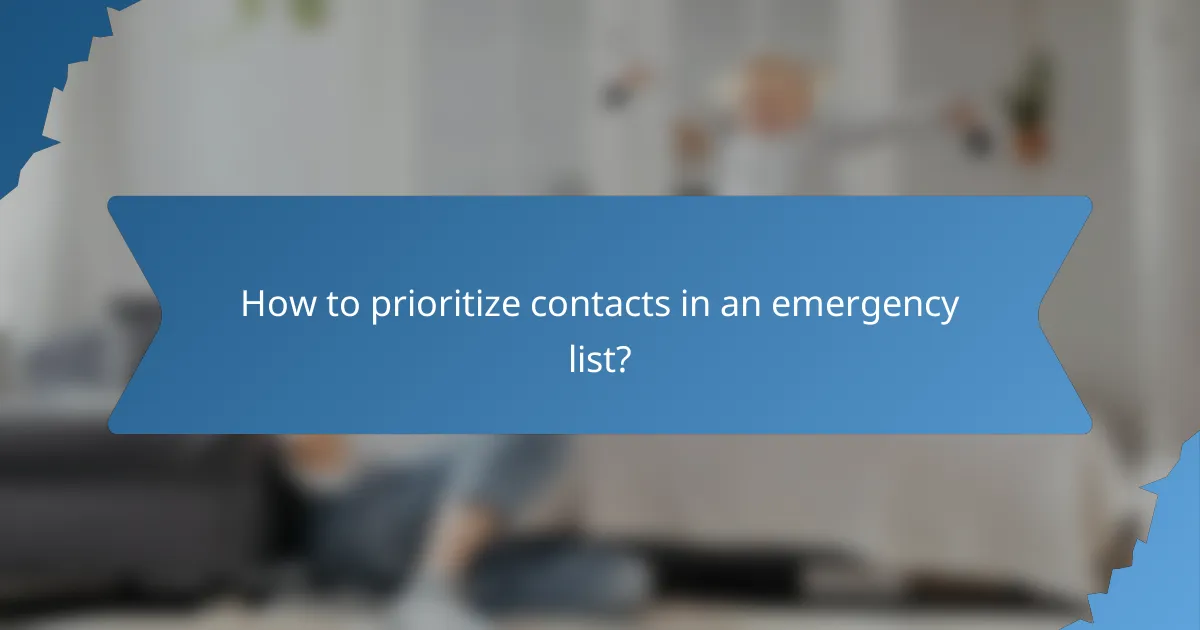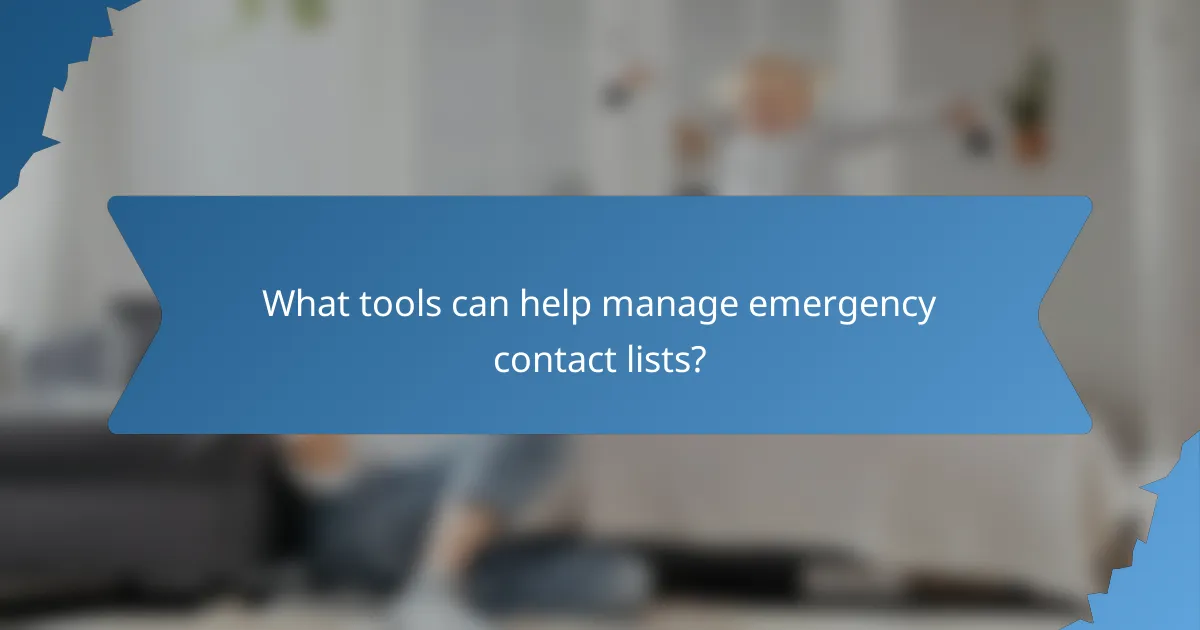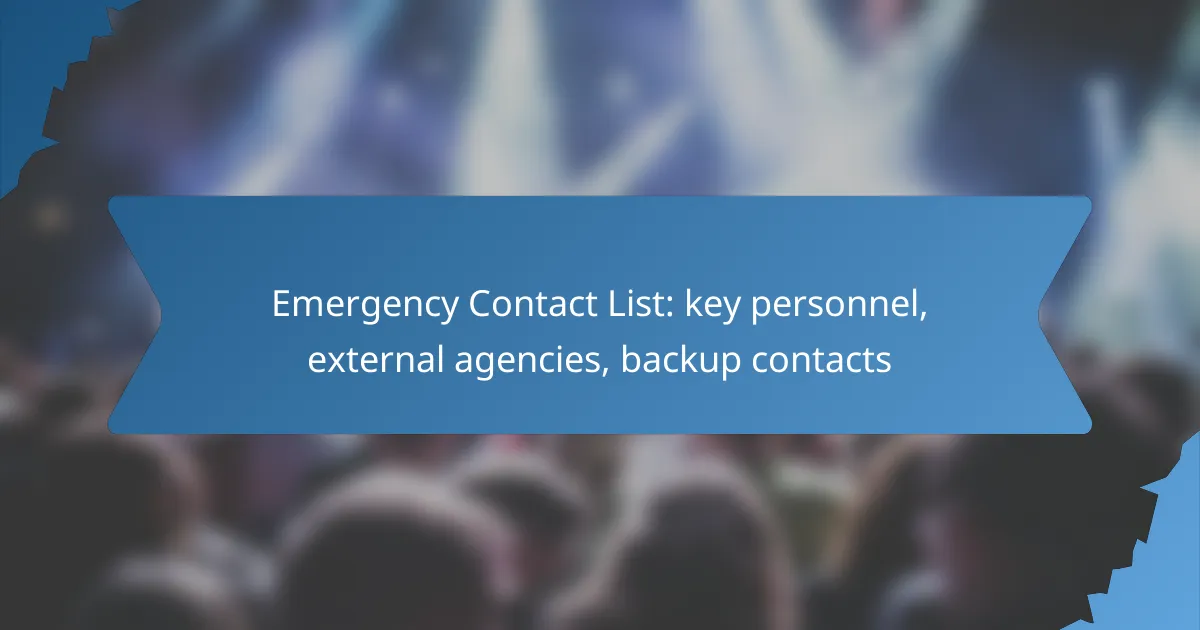An emergency contact list is essential for ensuring swift communication and coordination during crises. It should encompass key personnel, external agencies, and backup contacts to facilitate an effective response. By having this information readily available, organizations can streamline their emergency management efforts and enhance overall safety.

What should be included in an emergency contact list in Canada?
An emergency contact list in Canada should include key personnel, external agencies, and backup contacts to ensure quick access during a crisis. This list is vital for effective communication and coordination in emergencies, helping to streamline response efforts.
Key personnel contacts
Key personnel contacts should include individuals who play critical roles in emergency response, such as team leaders, safety officers, and department heads. Each entry should contain the person’s name, title, phone number, and email address for easy communication.
Consider organizing these contacts by department or function to facilitate quick access. Regular updates are essential to ensure that all information remains current, especially when personnel changes occur.
External agency contacts
External agency contacts encompass local emergency services, such as police, fire departments, and medical services. Include the main contact numbers for these agencies, as well as any relevant non-emergency lines.
Additionally, consider including contacts for utility companies, poison control, and local health departments. This information can be crucial during emergencies that involve hazardous materials or health risks.
Backup contacts
Backup contacts are essential for redundancy and should include alternative personnel who can step in if primary contacts are unavailable. This could involve listing secondary phone numbers or emails for key personnel.
It’s advisable to have at least two backup contacts for each key role to ensure that someone is always reachable. Regularly review and update these contacts to reflect any changes in personnel or roles.

Who are the key personnel for emergency situations?
The key personnel for emergency situations typically include members of the management team and safety officers. These individuals are crucial for coordinating responses and ensuring safety protocols are followed during crises.
Management team
The management team plays a vital role in emergency situations by providing leadership and making critical decisions. They are responsible for developing emergency plans, allocating resources, and communicating with stakeholders.
In many organizations, the management team should include a designated emergency coordinator who oversees the implementation of emergency procedures. Regular training and drills can help ensure that all team members are prepared to act swiftly and effectively when needed.
Safety officers
Safety officers are essential for maintaining workplace safety and compliance with regulations. They conduct risk assessments, implement safety protocols, and serve as the primary point of contact during emergencies.
These officers should be trained in first aid, fire safety, and emergency response procedures. It’s beneficial for safety officers to have clear communication channels with the management team to facilitate quick decision-making during a crisis.

Which external agencies should be contacted during emergencies?
During emergencies, it is crucial to contact specific external agencies that can provide immediate assistance. Key personnel typically include local police, fire services, and emergency medical services, each playing a vital role in ensuring safety and managing the situation effectively.
Local police department
The local police department is essential for handling criminal activities, traffic accidents, and public safety threats. They can respond quickly to emergencies, enforce laws, and provide crowd control when necessary.
When contacting the police, provide clear information about the situation, including your location and any immediate dangers. In the United States, dialing 911 will connect you to emergency services, including the police.
Fire services
Fire services are critical for responding to fires, hazardous materials incidents, and rescue operations. They are trained to handle various emergencies, from structural fires to wildfires, ensuring public safety and property protection.
In case of a fire, call the fire department immediately, providing details about the fire’s location and size. In many regions, the fire department can be reached through the same emergency number as the police.
Emergency medical services
Emergency medical services (EMS) are responsible for providing urgent medical care and transportation to hospitals. They are equipped to handle medical emergencies, including injuries, heart attacks, and other critical health issues.
When contacting EMS, clearly state the nature of the medical emergency and the condition of the patient. In most areas, EMS can be reached through the same emergency contact number, ensuring a swift response.

How to prioritize contacts in an emergency list?
To prioritize contacts in an emergency list, focus on those who can provide immediate assistance and critical support. This typically involves identifying key personnel and external agencies that can respond quickly and effectively to the situation at hand.
Critical response teams first
Critical response teams should be at the top of your emergency contact list. These include local police, fire departments, and medical emergency services. Their quick response is vital in life-threatening situations, and having their contact information readily available can save precious time.
When listing these contacts, ensure you include multiple ways to reach them, such as phone numbers and email addresses. For example, local police may have a non-emergency line in addition to 911, which can be useful for less urgent situations.
Support services next
After critical response teams, include support services that can assist in recovery and follow-up. This may consist of local hospitals, mental health services, and community organizations that provide aid during crises. Their role is essential for ongoing support after the immediate danger has passed.
Consider creating a small table to organize these contacts, listing the service name, contact number, and type of support offered. For instance:
| Service Name | Contact Number | Type of Support |
|---|---|---|
| Local Hospital | (123) 456-7890 | Emergency Medical Care |
| Mental Health Crisis Line | (987) 654-3210 | Emotional Support |
Regularly review and update this list to ensure all information is current and accurate, as contact details can change frequently.

What are the best practices for maintaining an emergency contact list?
Maintaining an emergency contact list involves regularly updating key personnel and external agencies to ensure quick access during crises. Best practices include establishing a clear protocol for updates and ensuring all staff can easily access the list.
Regular updates
Regular updates to the emergency contact list are crucial for accuracy and effectiveness. Schedule reviews at least quarterly or whenever there are significant changes in personnel or agency contacts. This ensures that the information remains current and reliable.
Consider using a shared digital platform that allows for real-time updates. This can help prevent outdated information from being circulated and ensures that everyone has access to the latest contacts.
Accessibility for all staff
Ensuring that the emergency contact list is accessible to all staff is vital for effective communication during emergencies. Use a centralized location, such as a secure intranet or a cloud-based document, where employees can easily find and reference the list.
Additionally, provide training on how to access and use the contact list effectively. This could include regular drills or informational sessions to familiarize staff with the procedure, ensuring everyone knows where to find critical contacts when needed.

How to ensure effective communication during emergencies?
Effective communication during emergencies relies on having a well-organized plan that includes key personnel, external agencies, and backup contacts. This ensures that information flows quickly and accurately to all relevant parties, minimizing confusion and enhancing response efforts.
Use of mass notification systems
Mass notification systems are essential tools for disseminating information rapidly during emergencies. These systems can send alerts via text messages, emails, and phone calls to a large number of people simultaneously, ensuring that everyone receives timely updates.
When implementing a mass notification system, consider the reliability of the technology and the ease of use for your team. Look for systems that allow for customization of messages and can reach multiple platforms, such as social media and mobile apps. Regular testing of these systems is crucial to ensure they function correctly when needed.
Establish clear protocols
Clear protocols outline the steps to be taken during an emergency, ensuring that everyone knows their roles and responsibilities. This includes defining who communicates with whom, what information needs to be shared, and the timing of these communications.
To create effective protocols, involve key personnel in the planning process and conduct regular training sessions. Use checklists to guide actions during an emergency and ensure that all staff are familiar with the procedures. Regularly review and update these protocols to adapt to changing circumstances or lessons learned from past incidents.

What tools can help manage emergency contact lists?
Effective management of emergency contact lists can be achieved through various tools that streamline organization and accessibility. Key options include specialized software designed for emergency management and cloud-based storage solutions that ensure contacts are readily available when needed.
Emergency management software
Emergency management software provides a centralized platform for storing and managing contact information for key personnel and external agencies. These systems often include features such as automated alerts, incident tracking, and reporting capabilities, which enhance communication during emergencies.
When selecting emergency management software, consider factors like user-friendliness, integration with existing systems, and the ability to customize contact categories. Popular options include tools like Everbridge and AlertMedia, which cater to various organizational needs.
Cloud-based storage solutions
Cloud-based storage solutions, such as Google Drive or Dropbox, allow for easy sharing and updating of emergency contact lists across teams. These platforms enable real-time collaboration, ensuring that all users have access to the most current information, regardless of their location.
To effectively use cloud storage for emergency contacts, establish clear naming conventions and folder structures. Regularly review and update the list to remove outdated contacts and add new ones, ensuring that the information remains relevant and useful during crises.
